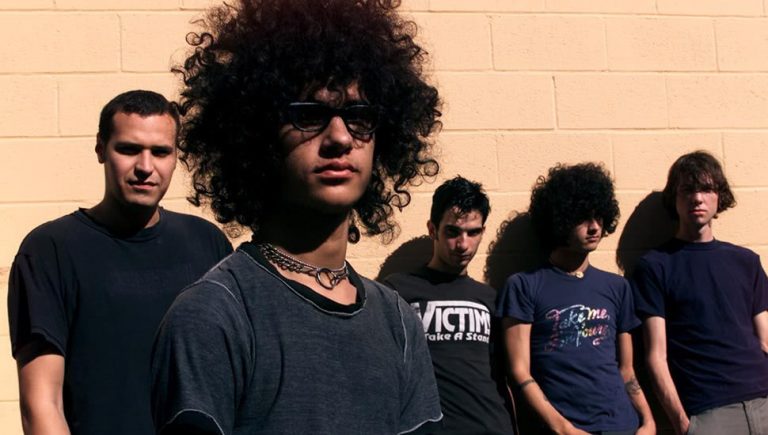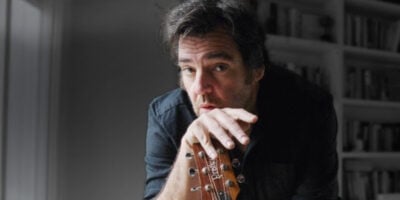The ’90s have long been described as the decade of grunge. With musicians tired of the hair metal scene of the ’80s, and with rebelliousness becoming more popular with every year, alternative rock turned towards the sweaty, fuzzy world of grunge music. But at this very same time, the genre of post-hardcore was starting to make its mark on the world.
With its roots in punk and hardcore music, this loud and raucous form of expression was exactly what the alternative music scene needed and, in 2000, a young band from Texas burst onto the scene ready to make the world listen to their own intensely refreshing take.
This Friday, At The Drive-In release their long-awaited fourth LP in • ter a • li • a, the band’s first since 2000’s era-defining Relationship Of Command. Now considered one of the very best rock records of the decade, we’re looking back at how At The Drive-In recorded their definitive masterpiece, and why fans have been wishing for its sequel for 16 years.

‘Governed By Contagions’ is At The Drive-In’s first music released since 2000’s era-defining Relationship Of Command.
Having formed in 1993 in the city of El Paso, Texas, At The Drive In quickly adapted to the ‘do-it-yourself’ ethos of punk and hardcore music, playing small shows wherever they could, promoting their music off their own backs, and doing everything possible to make a name for themselves without the help of major record labels.
After releasing their debut album Acrobatic Tenement for the meagre sum of $600, their profile began to rise almost immediately as they toured with a number of established bands like AFI, Face To Face, and even Australia’s legendary Cosmic Psychos. The group had already suffered through some pretty tough times, however, and had briefly broken up before the record’s release.
Having reconvened and started fresh, their newfound success allowed them to record a follow-up, In/Casino/Out, released on the legendary Fearless Records label. With this record also being well received (and now regarded as a classic of the emo and post-hardcore genres), their star continued to rise, and now they were touring with bands like Jimmy Eat World, hitting Europe for the first time.

In early 2000, following a tour in which they supported the legendary Rage Against The Machine, the band gathered together with the intention of recording their third album, and working with producer Ross Robinson (Korn, Fear Factory), and engineer Andy Wallace (Nirvana, Sonic Youth), they were in fine hands. After a seven week recording process, which even saw Iggy Pop brought in for a guest spot, At The Drive-In were ready to unleash Relationship Of Command onto an unsuspecting public.
The response was intense. The album received rave four and five star reviews from publications such as NME, The Village Voice, and Entertainment Weekly, and were thrust even further into the public spotlight with televised appearances on The Late Show With David Letterman, and Late Night with Conan O’Brien. The group again traveled around the world, with appearances including a legendarily short set at the 2001 Big Day Out festival. But then, with a massive record on their hands and only one month short of heading out on a US tour, At The Drive-In broke up.
After a “non-stop six-year cycle of record/tour/record/tour,” the band announced, “we are going on an indefinite hiatus,” but members of the band, including guitarist Omar Rodriguez, assured fans that the band just needed “time to rest up and re-evaluate, just to be human beings again and to decide when we feel like playing music again.”
The music world was shocked by the news, and fans were gutted. After all, just six months earlier they had released their magnum opus, a record which NME called “absolutely storming”, claiming that the group were quite possibly the “best live band ever.” Of course, with a sudden hiatus coming almost directly after the release of an already-legendary album, fans even then knew that At The Drive-In would be spoken of with reverence for years to come. They had no way of knowing that they wouldn’t see another record from the band for over a decade and a half, but they’d been left with am era-defining record to listen to in the meantime.

Why has Relationship Of Command managed to display such awe-inspiring staying power, and why now is it still considered a groundbreaking and legendary album? While upon its release it was considered to be one of the most aggressive and emotionally-complex records the genre had seen, it’s now looked back upon even more favourably as one of the most influential releases in rock’s more recent history.
When re-reviewed as part of a ten-year retrospective by the BBC back in 2010, their writers acknowledged that part of the album’s legendary status has formed because fans were left wondering what would have happened next. The band’s live performances were legendary in their own time, but once they broke up, new fans were left not with countless hours of YouTube clips, but instead tales of the intense, mind-blowing shows that At The Drive-In could deliver.
Other critics, such as Allmusic’s Blake Butler, would sum up the record by calling it “one of the most infecting and mind-blowing rock albums in a long time,” noting the “beautiful vocals bursting passion in quirky, abstract, and often thrilling lyrics, youthful energy, driving melodies, and a sense of beyond-the-moment urgency.” Of course, one would argue that these elements haven’t been entirely lacking in music in recent years, but a large number of bands could trace their own lineage to At The Drive-In’s Relationship Of Command, whether directly or indirectly.

Of course, soon after the breakup, At the Drive-In’s two main members, guitarist Omar Rodríguez-López and vocalist Cedric Bixler-Zavala, would reunite by forming The Mars Volta, while other guitarist Jim Ward would join up with the group’s drummer Tony Hajjar to form Sparta with guitarist Keeley Davis – both becoming successful acts in their own right, although one slightly more than the other.
Obviously, this means that the band never truly left our sights. After all, if you wanted to go and listen to Cedric Bixler-Zavala’s breathtaking voice, or the complex guitar work of Omar Rodríguez-López, all you had to do was wait for festival season, as they were frequent visitors to our shores in their new guise. But at the end of the day, even a band like The Mars Volta couldn’t quite match the sheer intensity and passion that we first witnessed with At The Drive-In.
Thankfully, in 2012, the group stunned fans by announcing a reformation, and Aussies were lucky enough to witness it in person when At The Drive-In came down here for Splendour In The Grass. Sadly, despite resulting in some memorable gigs, the reformation was mostly a tease, with no new music to be found. But with Relationship Of Command in their repertoire and sounding as vital as ever, it was hard to complain too fiercely.

But now, after having reformed last year, and having toured our country once again, At The Drive-In have reformed in the way that the music world has always hoped for. Not only are we seeing live shows, but with the group’s fourth record, In•ter a•li•a, finally releasing this Friday, fans are ecstatic at the prospect of seeing this legendary band in action once more with some new songs to fall in love with.
Are the band still relevant 16 years after their infamous breakup? Cedric Bixler-Zavala’s much-talked about vocals and stage antics are still on display, and he’s still putting on shows that make it seem like the group haven’t aged a day since their initial breakup. The highly accomplished guitar work of Omar Rodríguez-López has only gotten better with age, and while one would think that releasing a mind-boggling 43 solo albums since 2004 might have left him short on ideas by now, the new singles released from in•ter a•li•a make it clear that his riffs and crushing chords are still as potent as ever. Likewise, bass guitarist Paul Hinojos, drummer Tony Hajjar, and the newly-recruited guitarist Keeley Davis (replacing his Sparta bandmate Jim Ward) all come together to bring together one of the tightest and most ferocious rhythm sections in rock music.
With an intensity undiminished by the intervening years, fans have been witnessing live shows that they have called as good as, if not better, than what they saw back when At The Drive-In were at their prime – and in•ter a•li•a promises to deliver in the same way. Whether or not it becomes as era-defining as its predecessor, we couldn’t be more excited to have At The Drive-In making music again.
At The Drive-In’s fourth record, in•ter a•li•a, is out Friday May 5 through Rise records, and can be preordered here.

































